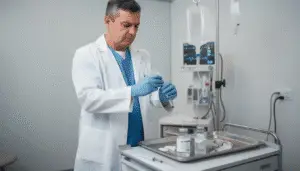Stem Cell Therapy For Injuries
Turn Back Time and Recover from Injuries faster than ever with Stem Cell Therapy: Age Gracefully and Feel Your Best.
Stem Cell Injection Therapy
Repairing Damage At The Cellular Level
When you’re injured, your body initiates a repair process, but sometimes this process needs extra support. Stem cell therapy can speed up and improve tissue repair by introducing new, healthy cells into the damaged area. This advanced treatment helps regenerate tissue, reduce inflammation, and accelerate recovery.

How Do Stem Cells Work For Injuries?
Stem cells are introduced into the site of injury, where they activate and transform into the necessary cell types to repair muscle, cartilage, or bone. These cells work to restore function and improve mobility, especially in areas that may have healed poorly or incompletely.


Benefits:
Stem cell therapy is a non-invasive and natural solution for injuries, allowing you to recover faster without relying on surgery or long-term medications.
- Speeds Up Recovery: Promotes faster healing of muscles, ligaments, and other tissues.
- Regenerates Damaged Tissue: Helps rebuild damaged cells, improving functionality.
- Reduces Inflammation: Lowers inflammation at the injury site for faster pain relief.
- Promotes Long-Term Healing: Ensures that healing is not only fast but complete, reducing future issues.
- Minimally Invasive: Offers a non-surgical treatment option to heal injuries.
More Stem Cell Treatments
Stem cell therapy offers a natural way to heal and rejuvenate your body. Whether you’re looking to slow down the aging process, boost your immune system, or find relief from pain and chronic conditions like arthritis, stem cells can help. These treatments tap into your body’s own power to repair and restore.
FAQ's
What is stem cell therapy?
Stem cell therapy uses the body’s natural cells to repair, regenerate, and heal damaged tissues. These cells have the unique ability to transform into different types of cells your body needs, like muscle, bone, or nerve cells. It’s a minimally invasive treatment that taps into the body’s own healing power to treat a range of conditions from injuries to chronic diseases.
How does stem cell therapy work?
Stem cells are collected from your own body (usually from bone marrow or fat tissue) or from other sources, then reintroduced into areas that need repair. Once there, these cells stimulate healing, reduce inflammation, and promote the regeneration of healthy tissue. Essentially, they target the damaged areas and work to restore proper function.
What conditions can stem cell therapy treat?
Stem cell therapy can help with a variety of conditions, including joint pain, arthritis, autoimmune diseases, neuropathy, chronic injuries, and even sexual dysfunction. It’s also used to improve immune response, manage pain, and help the body recover faster after trauma or surgery.
Is stem cell therapy safe?
Yes, stem cell therapy is generally considered safe, especially when using your own cells. Since it’s a natural process and minimally invasive, there’s a lower risk of complications compared to surgeries or medications. However, like any medical treatment, it’s important to discuss potential risks with your doctor.
How long does it take to see results?
Results vary depending on the condition being treated and the individual. Some people notice improvements within weeks, especially with pain relief and mobility. For others, the full benefits of tissue regeneration and healing can take a few months. It’s a gradual process, but the results are long-lasting.
How many treatments will I need?
The number of treatments varies depending on your condition and how your body responds. Some patients experience significant improvement after just one session, while others may need multiple treatments for the best results. Your doctor will personalize a treatment plan based on your specific needs.
Caution: The treatment may not be effective or appropriate for all patients, additional side effects may occur, and all patients should talk to their physician to learn more about the treatment and potential risks.




